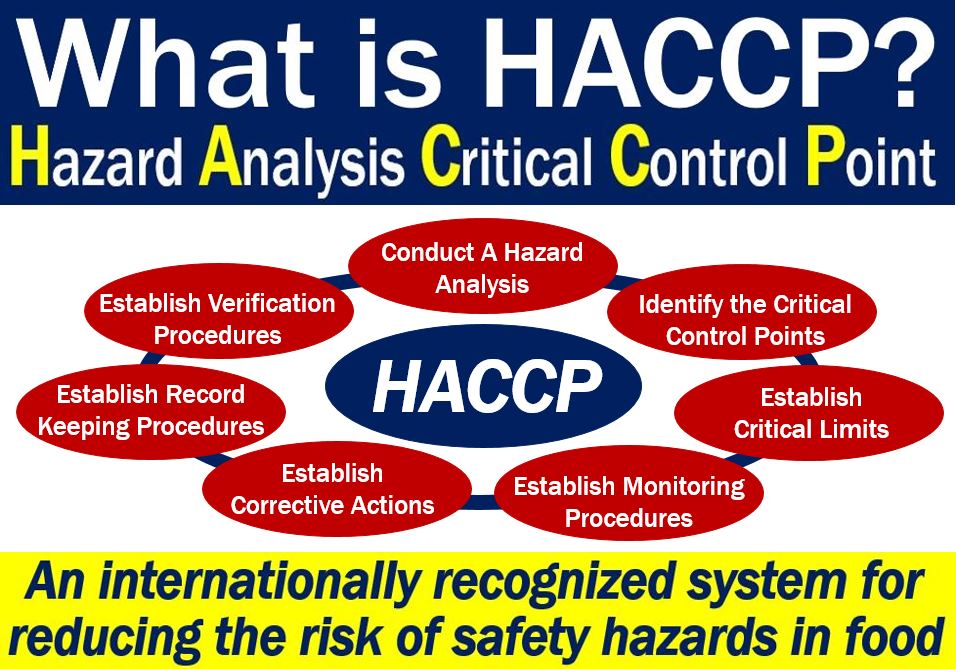HACCP stands for Hazard Analysis Critical Control Point. It is a food safety management system which some 150 countries have adopted. Stakeholders analyze and control for physical, chemical, and biological hazards from the production of raw materials, to final consumption.
The HACCP system aims to identify and control potential hazards at specific points in the process.
Put simply; HACCP is a system for reducing the risk of safety hazards in food. Countries across the world recognize the system.
HACCP aims to prevent contamination, rather than end-product evaluation. In other words, rather than relying just on food inspectors, producers also ensure food safety.
The US Food and Drug Administration (FDA) says the following on its website:
“HACCP is a management system in which food safety is addressed through the analysis and control of biological, chemical, and physical hazards from raw material production, procurement and handling, to manufacturing, distribution and consumption of the finished product.”

HACCP – seven principles
There are seven principles in the HACCP system.
Conduct a Hazard Analysis
The team must make a list of the steps in the process. It is also necessary to identify where significant hazards are most likely to occur.
The team must focus on hazards that we can prevent, eliminate, and also control with the HACCP plan.
Identify the Critical Control Points
CCPs (critical control points) are points in the procedure where we can apply control. They are also at points where we can prevent, eliminate, or reduce hazards to acceptable levels.
The team uses a CCP decision tree to help determine where the critical control points are in the process.
According to the Institute of Agricultural and Natural Resources at the University of Nebraska-Lincoln:
“A critical control point may control more that one food safety hazard or in some cases more than one CCP is needed to control a single hazard.”
“The number of CCP’s needed depends on the processing steps and the control needed to assure food safety.”
Establish Critical Limits
This means establishing maximum and minimum values. Specifically, values to which we must limit a physical, chemical, or biological parameter. The aim, above all, is to prevent a food safety hazard.
The aim is also to eliminate or reduce a food safety hazard to an acceptable level.
The team should apply critical limits to water activity (Aw), pH, temperature, and time. There are also some other measures that are relevant to regulatory standards or scientific literature.
Monitoring Critical Control Points (CCPs)
The team will describe how we should monitor procedures for the measurement of the critical limit. In fact, it must do this for each CCP.
The monitoring procedures must describe how to take the measurement, when to take it, and who is responsible. They should also describe how often we should take the measurement during production.
Establishing Corrective Action
When a critical limit occurs, we need to take corrective actions. In other words, we need to fix it.
The team will determine which steps to take to prevent potentially hazardous food from getting into the food chain.
Additionally, the team must also explain what steps we must take to correct the process.
Regarding these steps, the Institute of Agriculture and Natural Resources says:
“This usually includes identification of the problems and the steps taken to assure that the problem will not occur again.”
Verification
This principle focuses on making sure that the HACCP system is operating according to plan.
This may include auditing CCPs, prior shipment reviews, record reviews, and product testing. It may also include instrument calibration.
Record-keeping
Record-keeping is a crucial component of the HACCP system. Only by recording information can we then prove that everybody in the food production process is keeping the food safe.
The records should contain information on the:
- HACCP team
- Corrective actions
- Record-keeping procedures
- Monitoring system
- Critical limits
- Verification procedures
HACCP works alongside other programs
The HACCP system does not exist in isolation. We must build it alongside other food safety programs such as GMPs and SSOPs. GMP stands for Good Manufacturing Practice, and SSOP stands for Sanitation Standard Operating Procedures.
